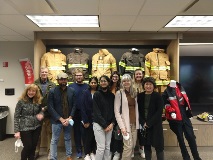LION Protects Interdisciplinary Trip, April 5, 2022
On April 5th, 2022, the ERC students had the opportunity to visit LION Protects, a company that designs and manufactures gear primarily for firefighters in Dayton, OH. Lion Protects specializes in first responder protective uniforms. The students got a chance to hear about both the product development side of the business, as well as visit one of the manufacturing plants where they produce some of the firefighting turnout uniforms and the chemical and biological safety uniforms.

Group of ERC students and faculty at LION Protects
Written by Ada Jesuthasan and Jory Gould
Lion’s Protects products and processes
One of the most important aspects of the LION Protects customer service is the opportunity for their customers to be able to customize their products while following the National Fire Protection Association (NFPA) codes and standards.
The jackets and pants utilize patented LION technologies to keep the firefighters more comfortable without compromising safety, which is the main focus of the product and development team. They are very attentive to the needs of the firefighters, therefore they create new products with innovative features, which can be successfully manufactured and used in the field.
On the manufacturing side, the production of firefighter pants, jackets, and one-piece suits, starts with printing the pattern for the customized product. Since these products are customizable per fire department, sizes and personalization, there are very few sets of products that are the same. This complicates the manufacturing process but is a valuable component that LION offers to their customers. After cutting the pattern of the product, the pieces are placed into bins so that the components of the product can be stored together. These bins make their way down the lines where workers are seated at sewing machines and can select the specialized portions of the product that they are responsible for sewing. As the bin moves down the line the suit becomes more and more complete. It takes approximately one full workweek to complete two to three suits, due to the rigorous attention to detail required when manufacturing the suits.

Machine used to cut fabric
The final step of production is quality control, where they double check all the suits by hand for leaks or any tears using various methods. For example, the chemical and biological suit is placed in a water bath and checked for bubbles. Once the suit passes inspection, it is placed in a room with humidifiers to fully dry. Any suit that requires rework, would be fully dried and taken back to the production floor for fixes. The final suit is assembled together and shipped to the customer.
Overall, getting to see this process and understand what goes into keeping our firefighters safe was eye-opening and a valuable experience.
Written by John Singletary and Swade Barned
On April 5, 2022, the ERC sponsored a trip for students to travel to LION Protects, a company that designs and manufactures gear primarily for firefighters in Dayton, OH.

Students try on some of the firefighter gear made by LION Protects
Within the manufacturing facility, there were some health risks identified for employees that are involved in the manufacturing process. Ergonomic risks were identified by our site hosts. Employees are required to sit at various sewing stations throughout the day to sew uniforms together. This creates risks of repetitive motion in the hands and awkward body postures for employees sitting at the sewing stations over an eight-hour shift.
Aside from ergonomic injuries or risks, needle injuries are also a risk present in the manufacturing process. The sewing process requires employees’ hands to be very close to needles, which creates a risk for a finger or portion of the hand to be caught in the needle.
Another risk was with the use of adhesive tape and potential exposures generated from the high heat process. Lion Protects had local exhaust ventilation in place to help reduce the risk of exposures.
Despite these risks, Lion Protects is doing an excellent job mitigating these risks, as identified visually and by our site hosts:
- To lower ergonomic risks, employees are trained to work at multiple sewing stations, meaning they do not have to remain at the same station over long periods.
- Employees can stand
- Employees can rotate to different stations to eliminate continuously repetitive motions and awkward postures over a long period of time.
- Rollers and shelves allow employees to easily access boxes and other tools that are needed for the process to lower risk of extended reach.
- Pedals to activate sewing machines, which removes the use of hands on the sewing machine.
- To combat the needle-injury risk, needle guards are used on sewing machines to prevent fingers from being easily caught in the machine.
- The other machine used, such as a cutter, have guards to prevent appendages from being caught in machines.
The tour was very informative and Lion Protects is very active regarding employee safety and well-being. The students thank the ERC and Lion Protects for this wonderful field experience opportunity.
Contact Us
Department of Environmental and Public Health SciencesEducation and Research Center (ERC)
Kettering Lab Building
Room 440
160 Panzeca Way
Cincinnati, OH 45267-0056
Mail Location: 0056
Phone: 513-558-5710
Fax: 513-558-2722
Email: erccoor@uc.edu